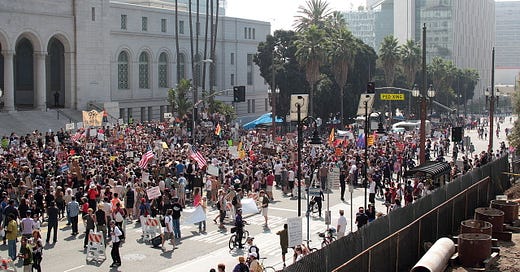When Numbers Don't Add Up: The California Deployment That Divided America
A fact-checker's guide to cutting through the noise on Trump's June 2025 federal intervention
The Setup
On June 10, 2025, President Trump authorized the deployment of 4,000 National Guard troops and 700 Marines to Los Angeles amid ongoing protests against federal immigration enforcement. Within hours, the internet exploded with competing narratives that would make a statistician weep.
Let's start with what actually happened—then dive into how both sides spun the same set of facts into completely different stories.
The Left's Narrative: "Military Occupation of America"
The Framing
Progressive outlets immediately labelled this a "military occupation" and "unprecedented federal overreach." Social media lit up with comparisons to martial law, with viral posts claiming Trump had "militarized California" with "thousands of federal troops."
The Deception
The most egregious misrepresentation came from amplifying the raw numbers without context. Headlines screamed about "4,700 federal forces deployed," but conveniently omitted that California already has 76,900 police officers—meaning federal forces represented just 5.76% of uniformed personnel in the state.
The Misinformation
Several viral TikTok posts claimed Marines were "patrolling neighbourhoods" and "making arrests." This was demonstrably false—federal forces were restricted to protecting federal property and personnel, with no general law enforcement authority.
What They Got Right
The deployment was indeed unusual. Active-duty Marines on U.S. soil for domestic purposes is rare and legally complex. The optics were undeniably provocative, and the legal challenges from California officials were legitimate.
The Right's Narrative: "Restoring Order to Chaos"
The Framing
Conservative media portrayed this as a measured response to "violent insurrection" and "state-level rebellion." The narrative emphasized California's "inability to protect federal assets" and framed the deployment as reluctantly necessary.
The Deception
The most misleading element was characterizing the protests as uniformly violent or threatening federal operations. While some incidents occurred, the vast majority of demonstrations were peaceful, and local law enforcement reported no requests for federal assistance.
The Misinformation
Claims that California had "lost control" were unsupported by crime statistics or incident reports. Some outlets suggested the deployment was at the "request of local authorities," which was categorically false—California's governor and LA's mayor both opposed it.
What They Got Right
Federal property does require protection, and there were legitimate security concerns around some federal facilities. The legal authority for such deployments, while controversial, does exist under specific circumstances.
The Numbers Game: What Both Sides Missed
Here's where it gets interesting. Both narratives ignored the most revealing statistic: the deployment ratio.
· California Police: 76,900 (94.24%)
· National Guard: 4,000 (4.90%)
· Marines: 700 (0.86%)
For every Marine deployed, there were already 110 local police officers on duty. This wasn't reinforcement—it was theater.
The Real Story: Political Calculus Over Public Safety
After cutting through the partisan fog, three facts emerge:
1. The deployment was legally questionable but not unprecedented. Similar actions occurred during the 1992 LA riots and various civil rights era interventions, though the circumstances differed significantly.
2. The operational impact was minimal. With such restrictive rules of engagement and limited scope, the federal forces functioned more as a symbolic presence than an operational game-changer.
3. The political impact was maximal. This move energized both bases while creating a constitutional crisis that will likely end up in federal court.e
The Reality
Here's what the data actually tells us: This wasn't about public safety—it was about power projection. When you deploy 0.86% of available uniformed personnel and generate 86% of the news coverage, you're not solving a policing problem. You're making a political statement.
The most telling detail? The deployment occurred on a Tuesday, peaked media attention by Thursday, and dominated weekend talk shows. The timing suggests this was always more about the news cycle than the security situation.
Both sides played their predictable roles in this theater, but the real story lies in what they didn't discuss: the growing federal-state tension over immigration enforcement, the legal precedents being set for future deployments, and the normalization of military imagery in domestic political disputes.
The Bottom Line
When politicians deploy Marines to solve problems that 77,000 police officers apparently can't handle, you're not witnessing law enforcement—you're watching political performance art. The question isn't whether it was legal or effective, but whether we're comfortable with this becoming the new normal.
Sometimes the most important story isn't what happened, but what everyone agreed not to talk about while it was happening
What do you think? Are we witnessing a new chapter in federal-state relations, or just the latest episode in America's ongoing political theater? Share your thoughts in the comments below.
Brought to you by factcheckfirst.org and verifyapp.cloud
Subscribe for more fact-based analysis that cuts through the partisan noise. Because in a world of hot takes, sometimes the coldest facts tell the warmest truths.



